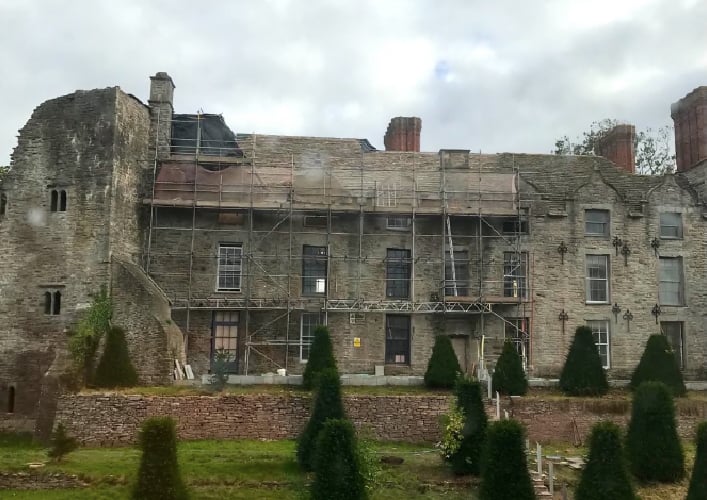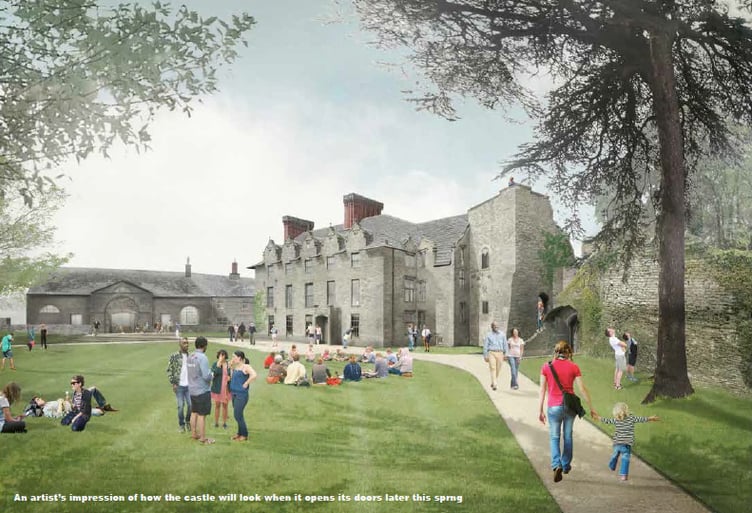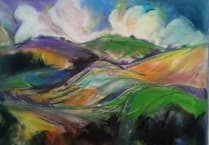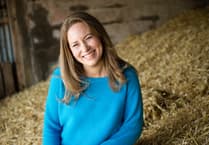Tom True may have spent three years working among the cultural icons of Rome, but he couldn’t be more excited about his new project, which will see him heading the project to open the 900-year-old doors of Hay Castle to the public for the first time ever.
Hay Castle may often be regarded as a forgotten piece of Powys history but under its new leadership it is looking to put itself back on the map with the exciting new public-facing project.
I was invited along to Hay to meet the castle’s new executive director, Dr Tom True, who allowed me a rare peep behind the scenes of the castle’s biggest restoration project in its 900-year history.
Although the castle is still something of a building site it is easy to see the modern feel that the restoration is aiming to create.
“We do want the castle to have a modern feel to it, but also with respect to the past and the great history that it holds,” explained Tom.
Spreading over three floors, the refurbishment gives the castle space for gallery rooms, touring exhibitions, educational projects, a café, and a reading room.
The exhibition, which visitors will experience, ends on a viewing platform offering a majestic view of the Wye Valley.
The castle also has a large open lawn area, where Tom hopes to hold events and gatherings, as well as a children’s play area.

As he was showing me around, Tom was visibly excited at the prospect of what the future holds for the historic site.
“It’s a sleeping giant for sure, it’s been dormant for so many years but has so much potential that we want to fulfill.”
For Tom, the project is a personal one, as he spent part of his honeymoon in the town of Hay.
Born in Somerset, Tom, has a PhD in Art History from Cambridge University, has recently relocated to Hay with his young family to join the team at the castle. After previously working in leadership roles in cultural institutions in London, Narbonne, and Rome, where he spent three years.
“There is no better city to live in than Rome, but I prefer to be back in the countryside,” said Tom.
Despite Somerset being around 100 miles away from Hay-on-Wye, Tom has always enjoyed trips to the historic market town, and said that he and his wife visited the town on their honeymoon which partly led to his interest in the castle.
With a turbulent history, Hay Castle was built by Lord William de Braose, a powerful Norman, in the late 12th century and was sacked by the last Prince of Wales, Llewelyn II, in 1233 and rebuilt by Henry III.
In the 15th century, the castle was passed on to the Beaufort Estates where it transformed into a more domestic setting with the Jacobean Manor badly damaged by fire - firstly in 1939 and then again in 1977.
Its more modern history has seen it change hands countless times after being sold by William Latham Bevan, a vicar in Hay who lived in the castle with his family for a large portion of the 19th century.
They were followed by Lady Dowager Glanusk, who lived in the castle in the 20th century before her death in 1935 after which, the castle was in the hands of Benjamin Guinness until he sold it to Edward Vernon Tuson in the 1940s or 1950s.

Tuson eventually sold the property to bibliophile and King of Hay, Richard Booth in the 1960s.
The site was on the market in 2011 when it was bought by the Hay Castle Trust with the aim of restoring it and opening it to the public.
The restoration has been made possible due to over £5 million from the National Heritage Lottery fund and £1.6 million match funding from various trusts and individual donors.
Dr Tom True, and his team of half a dozen, are hoping to open up the site to the public in May before the start of the Hay Festival, which runs from the May 26-June 5. They are also hoping to incorporate the local community in the castle and their projects.
“We want to embrace the community” said Tom, “Around 75 per cent of the activities we will be doing will be learning based activities and we want to have school visits where children can learn about the local history and also take part in workshops.
“It’s all about being a hub for the whole town, I want the local people to see a part of themselves in the castle when they visit and we hope to host cultural events for local people as well as visitors,” said Tom
Helping with this aim will be the historic depiction of Hay-on-Wye that will be part of the tour experience and will include not only the history of the castle but the growth of Hay as a town of books. They are hoping to host cultural events for locals to be involved in the castle as well.
There will be no admission fee for visitors when touring the castle but there are plans for a gift shop and a café is already in place, with Hereforshire firm, Epicure Events already announced as he new caterer.
An exclusive contract has also been signed making Epicure Events the caterer of events held at Hay Castle once it opens in the summer.
All in all the future is set to be an exciting one for Hay Castle, proving that even after 900 years there’s always a chance for a fresh new start.

An artist’s interpretation of how Hay Castle will look when it opens in spring
Hay Castle - a potted history - History from Hay Castle Trust
Hay Castle is one of the great medieval defense structures on the border of England and Wales still standing.
Built in the late 12th century by the powerful Norman Lord William de Braose, its history is long and turbulent. The castle was sacked by Llewelyn II, the last prince of Wales, in 1233, and rebuilt under the custody of Henry III.
Centuries of turmoil followed until the 15th century, when the castle passed into the hands of the Beaufort Estates.
Relative peace meant that the site could transform into a more domestic setting something which appears to have happened in two distinct phases.
Dating the first phase is as yet unclear although dendrochronolgy has dated the main double pile house as being built before the civil war from timber felled in 1636 The multi-gabled Jacobean manor was severely damaged by fire in 1939, and again in 1977.
For a large portion of the 19th century the castle was lived in by the Bevan family as William Latham Bevan was the vicar in Hay and later became an Archdeacon. He and his daughters were highly involved in daily life in the town and are mentioned in Kilvert’s diaries from the 1870s as Kilvert was a regular guest at the Castle.
During the early 20th century the Castle was lived in by Lady Dowager Glanusk. After her death in 1935 the property was in the hands of Benjamin Guinness when the 1939 fire broke out.
WWII probably contributed to the dereliction of the eastern section and at some point in the 1940s or 1950s the property was purchased by Edward Vernon Tuson. Tuson had married into the Studt fairground family and it was he who sold it to bibliophile and King of Hay, Richard Booth in the 1960’s. The site was purchased in 2011 by the Hay Castle Trust when Booth decided to put the Castle up for sale.





Comments
This article has no comments yet. Be the first to leave a comment.